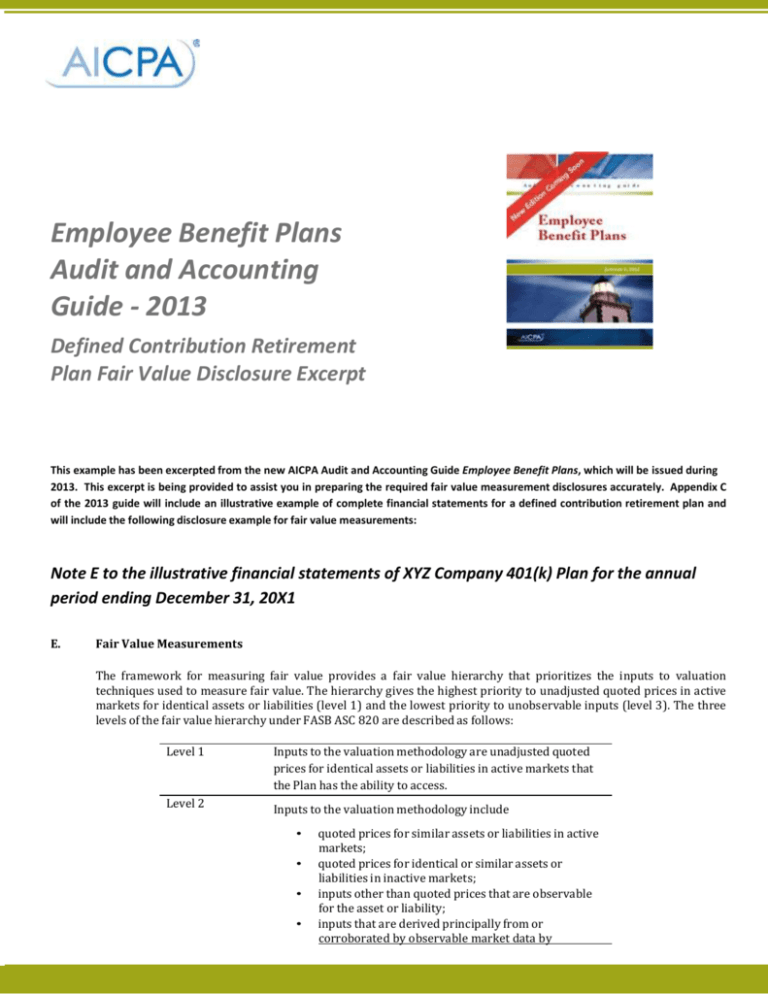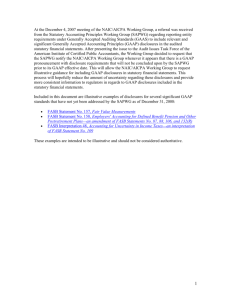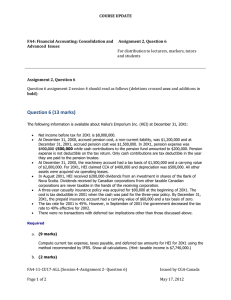
Employee Benefit Plans
Audit and Accounting
Guide - 2013
Defined Contribution Retirement
Plan Fair Value Disclosure Excerpt
This example has been excerpted from the new AICPA Audit and Accounting Guide Employee Benefit Plans, which will be issued during
2013. This excerpt is being provided to assist you in preparing the required fair value measurement disclosures accurately. Appendix C
of the 2013 guide will include an illustrative example of complete financial statements for a defined contribution retirement plan and
will include the following disclosure example for fair value measurements:
Note E to the illustrative financial statements of XYZ Company 401(k) Plan for the annual
period ending December 31, 20X1
E.
Fair Value Measurements
The framework for measuring fair value provides a fair value hierarchy that prioritizes the inputs to valuation
techniques used to measure fair value. The hierarchy gives the highest priority to unadjusted quoted prices in active
markets for identical assets or liabilities (level 1) and the lowest priority to unobservable inputs (level 3). The three
levels of the fair value hierarchy under FASB ASC 820 are described as follows:
Level 1
Level 2
Inputs to the valuation methodology are unadjusted quoted
prices for identical assets or liabilities in active markets that
the Plan has the ability to access.
Inputs to the valuation methodology include
•
•
•
•
quoted prices for similar assets or liabilities in active
markets;
quoted prices for identical or similar assets or
liabilities in inactive markets;
inputs other than quoted prices that are observable
for the asset or liability;
inputs that are derived principally from or
corroborated by observable market data by
correlation or other means.
If the asset or liability has a specified (contractual) term, the
level 2 input must be observable for substantially the full term
of the asset or liability.
Level 3
Inputs to the valuation methodology are unobservable and
significant to the fair value measurement.
The asset or liability’s fair value measurement level within the fair value hierarchy is based on the lowest level of any
input that is significant to the fair value measurement. Valuation techniques maximize the use of relevant observable
inputs and minimize the use of unobservable inputs.
Following is a description of the valuation methodologies used for assets measured at fair value. There have been no
changes in the methodologies used at December 31, 20X1 and 20X0.
Common stocks: Valued at the closing price reported on the active market on which the individual securities are
traded.
Corporate bonds: Valued using pricing models maximizing the use of observable inputs for similar securities. This
includes basing value on yields currently available on comparable securities of issuers with similar credit
ratings.
Mutual funds: Valued at the daily closing price as reported by the fund. Mutual funds held by the Plan are open-end
mutual funds that are registered with the Securities and Exchange Commission. These funds are required to
publish their daily NAV and to transact at that price. The mutual funds held by the Plan are deemed to be
actively traded.
Collective trust fund: Valued at the net asset value (NAV) of units of a bank collective trust. The NAV, as provided by
the trustee, is used as a practical expedient to estimate fair value. The NAV is based on the fair value of the
underlying investments held by the fund less its liabilities. This practical expedient is not used when it is
determined to be probable that the fund will sell the investment for an amount different than the reported
NAV. Participant transactions (purchased and sales) may occur daily. Were the Plan to initiate a full
redemption of the collective trust, the investment advisor reserves the right to temporarily delay
withdrawal from the trust in order to ensure that securities liquidations will be carried out in an orderly
business manner.
U.S. government securities: Valued using pricing models maximizing the use of observable inputs for similar
securities.
Guaranteed investment contract: Guaranteed investment contracts are valued at fair value by the insurance company
by discounting the related cash flows based on current yields of similar instruments with comparable
durations considering the creditworthiness of the issuer (see note F). Since the participants transact at
contract value, fair value is determined annually for financial statement reporting purposes only. In
determining the reasonableness of the methodology, the Investment Committee evaluates a variety of factors
including review of existing contracts, economic conditions, industry and market developments, and overall
credit ratings. Certain unobservable inputs are assessed through review of contract terms (for example,
duration or payout date) while others are substantiated utilizing available market data (for example, swap
curve rate).
The following table sets forth by level, within the fair value hierarchy, the Plan’s assets at fair value as of December
31, 20X1 and 20X0:
Assets at Fair Value as of December 31, 20X1
Level 1
Mutual funds:
Index funds
$2,262,500
Level 2
$—
Level 3
$—
Total
$2,262,500
Balanced funds
1,375,000
—
—
1,375,000
800,000
—
—
800,000
25,000
—
—
25,000
4,462,500
—
—
4,462,500
490,000
—
—
490,000
Telecommunication
470,000
—
—
470,000
Total common stocks
960,000
—
—
960,000
—
1,422,000
—
1,422,000
---
307,500
—
307,500
225,000
—
225,000
—
—
1,515,000
1,515,000
$5,422,500
$1,954,500
$1,515,000
$8,892,000
Fixed income funds
Other funds
Total mutual funds
Common stocks:
Industrial
Collective trust fund– S&P 500
Corporate bonds (Aaa credit
rating)
U.S. government securities
Guaranteed investment
contract
Total assets at fair value
Assets at Fair Value as of December 31, 20X0
Level 1
Mutual funds:
Index funds
Level 2
Level 3
Total
$2,000,000
$—
$—
$2,000,000
1,150,000
—
—
1,150,000
Fixed income
400,000
—
—
400,000
Other funds
100,000
—
—
100,000
3,650,000
—
—
3,650,000
450,000
—
—
450,000
Telecommunication
420,000
—
—
420,000
Total common stocks
870,000
—
—
870,000
Collective trust fund– S&P 500
—
2,100,000
—
2,100,000
Corporate bonds
---
255,000
—
255,000
120,000
—
120,000
—
—
$660,000
660,000
$4,520,000
$2,475,000
$660,000
$7,655,000
Balanced funds
Total mutual funds
Common stocks:
Industrial
U.S. government securities
Guaranteed investment
contract
Total assets at fair value
The following table sets forth a summary of changes in the fair value of the Plan’s level 3 assets for the year ended
December 31, 20X1.
Level 3 Assets
Year Ended December 31, 20X1
Guaranteed
Investment
Contract
Balance, beginning of year
Realized gains/(losses)
Unrealized gains/(losses)
relating to instruments
still held at the reporting
date
Purchases
Sales
Transfers in and/or out of
level 3
Balance, end of year
The amount of total gains
or
losses for the period
attributable to the
change in unrealized
gains
or losses relating to
assets
still held at the reporting
date
$660,000
5,000
40,000
835,000
(25,000)
—
$1,515,000
$40,000
Unrealized gains/(losses) from the guaranteed investment contract are not included in the statement of changes in net assets
available for benefits as the contract is recorded at contract value for purposes of the net assets available for benefits.
Quantitative Information about Significant Unobservable Inputs Used in Level 3 Fair Value Measurements
The following table represents the Plan's level 3 financial instruments, the valuation techniques used to measure the fair
value of those financial instruments, and the significant unobservable inputs and the ranges of values for those inputs.
Instrument
Fair Value
Principal
Valuation
Technique
Unobservable
Inputs
Range of
Significant
Input Values
Weighted
Average
Guaranteed
investment
contract
$1,515,000
Discounted Cash
Flow
Swap Yield Rates
1.749 - 2.707
Duration
2.3 – 2.7
Payout Date
6/28/13 –
12/31/13
Payout
Percentage
Y%
33% - 100%
Fair Value of Investments in Entities that Use Net Asset Value
The following table summarizes investments measured at fair value based on net asset value (NAVs) per share as of
December 31, 20X1 and 20X0, respectively.
December 31, 20X1
Collective trust fund –
S&P 500 1
Fair Value
Unfunded
Commitments
$1,422,000
n/a
Fair Value
Unfunded
Commitments
$2,100,000
n/a
December 31, 20X0
Collective trust fund –
S&P 5001
Redemption
Frequency (if
currently
eligible)
Daily
Redemption
Frequency (if
currently
eligible)
Daily
Redemption
Notice Period
30 days
Redemption
Notice Period
30 days
More information on this topic is included in the 2013 edition of the AICPA Audit and Accounting
Guide Employee Benefit Plans as well as in additional AICPA employment benefit plans
publications.
For more guidance like this, visit the AICPA store for a 30 day free trial of our Online Professional
Library today.
1
FASB ASC 820-10-50-6A requires disclosure of a description of the significant investment strategies. This
illustration assumes that the title of the investment, that is S&P 500, clearly shows the investment strategy for this
investment. If the investment strategy is not clearly recognizable through the title of the investment then further
disclosure would be required.
DISCLAIMER: This publication has not been approved, disapproved or otherwise acted upon by any senior technical committees of, and does not represent an official position of, the American Institute of Certified Public
Accountants. It is distributed with the understanding that the contributing authors and editors, and the publisher, are not rendering legal, accounting, or other professional services in this publication. If legal advice or
other expert assistance is required, the services of a competent professional should be sought.
Copyright © 2012 by American Institute of Certified Public Accountants, Inc. New York, NY 10036-8775. All rights reserved. For information about the procedure for requesting permission to make copies of any part of
this work, please email copyright@aicpa.org with your request. Otherwise, requests should be written and mailed to the Permissions Department, AICPA, 220 Leigh Farm Road, Durham, NC 27707-8110.












